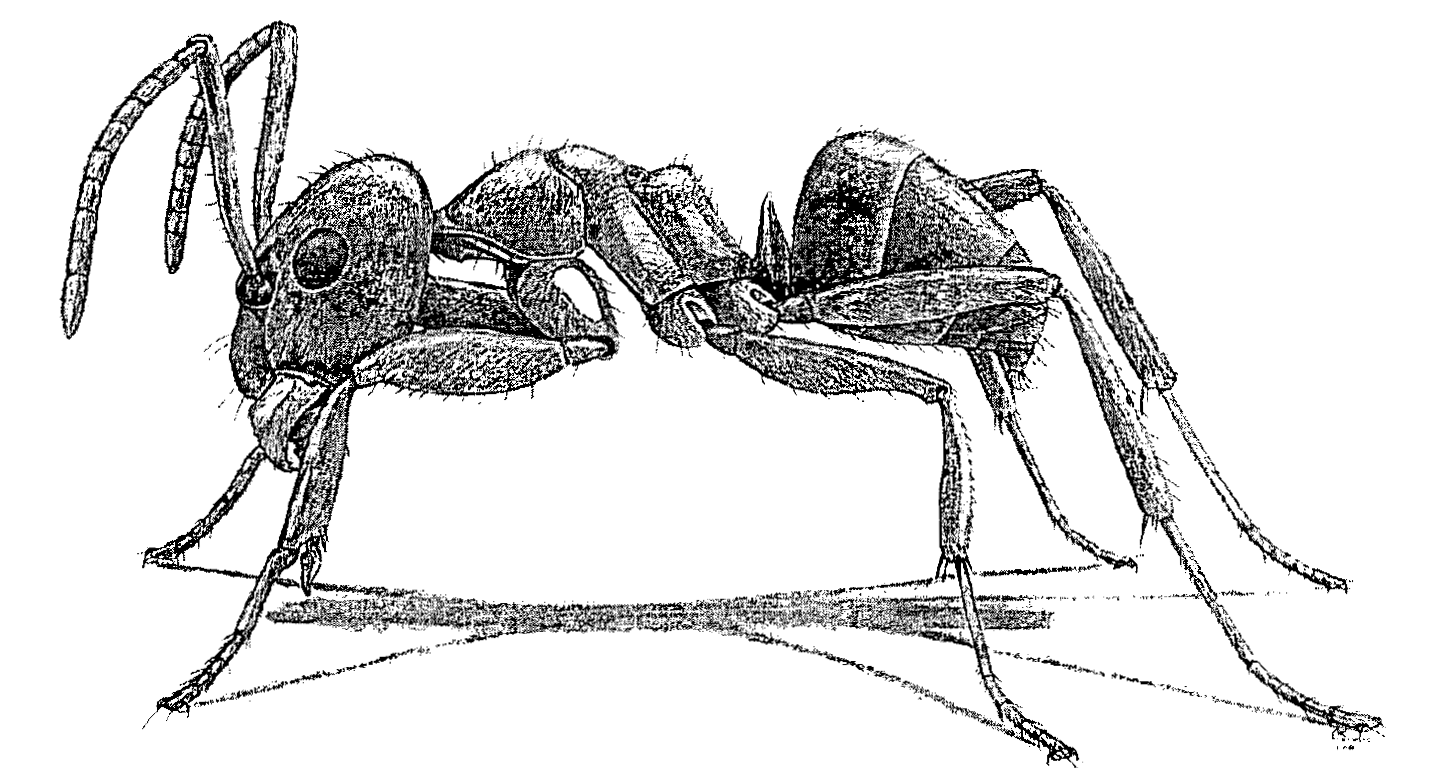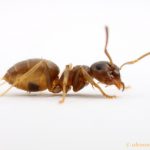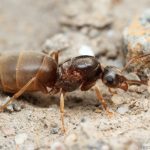
This is the dominant ant of open lawns and¬†fields in our area, and is replaced in woodlands by L. alienus. It is one of the two most common species in Ohio, and likely one of the most common of all insects in our area. The common name of “Cornfield Ant,” “officially” applied to L. alienus, which is a woodland species, was obviously intended to be used for L. neoniger and was based on misidentifications. I am taking the bold step here of properly utilizing this common name where it was intended, for Lasius neoniger.
Yellowish-brown to me dium brown, mandibles paler (yellowish-brown), anten­nae and legs brownish-yellow, femora broadly infuscated medially; head, alitrunk. and gaster micropunctate with covering of micropubescence giving a grayish or sil­very sheen, surface moderately dull to weakly glossy. The more abundant pilosity of L neoniger,as outlined in the key, will serve to distinguish this species from alie­nus in our area. This species is consistently paler in color, more pilose, and has a denser covering of ap­pressed pubescence (producing a whitened or dull ap­pearance) as compared to alienus (q.v. for further com­ments). The presence of erect hairs on scapes and tibiae, if present, is diagnostic for neoniger in Ohio, but very frequently they are nearly or completely absent, and thus are useless as a key character.
There has been a major problem differenti­ating L a/ienus from neoniger in the past, largely based on the strict reliance on presence or absence of erect hairs on the scapes and tibiae. If this and the obs cu re mandibular tooth character are bypassed, and pilosity in other areas as presented in the key is utilized, the two species are found to be consistently different, at least in our area. [I make no claims that these charac­ters will hold up outside of our region, especially in western U.S. and Europe, but this question should be investigated further. Note that Wheeler & Wheeler ( 1986) included L. niger (sensu Wilson ( 1955) for west­ern U.S. populations) under L. alienus.] Creighton ( 1950) describes a difference in head shape, with the sides more nearly parallel in neoniger.
A further character, utilized in Creighton ( 1950), com­pares the virtually unimpressed promesonotal suture and even profile of a/ienus with the distinctly impressed suture and interrupted outline of neoniger. I find this character to be too subtle and unreliable to have any diagnostic utility. Based on this feature, Creighton ( 1950) considered the often used figure of alienus from Smith ( 1947) to actually represent neoniger, underscor­ing the problems of identification that have plagued these two common species. In summary, the characters outlined in the present key, once compared and appreciated, will reliably and consistently separate these two species at least in Ohio, and very likely throughout northeastern North America. Most of the Ohio literature confused these two com­mon species, and used outdated nomenclature (see syn­onymy above).
With single queen (monogy­nous) (Holldobler & Wilson, 1990). Colonies may be large with numerous small, crater-like openings in an area (Headley, 1941 ), then are reduced to a central core at the end of the season
Holldobler & Wilson ( 1994) nickname this spe¬≠cies the “Labor Day ant.” During the end of Aug. and the first few weeks in Sept., if rain has recently fallen but it is now sunny and the air is warm, still, and humid, vast swarms of winged males and fe¬≠males emerge from their nests around 5:00 PM for a vast mating flight lasting just an hour or two until¬†twilight. Mating takes place during flight, then the newly mated females land, shed their wings, then search for a suitable place to dig their nest in the now moist soil. But few survive the gauntlet of aerial and ground predators.
Size
Nuptial Flight Dates
Habitat
Food
Behavior
Nesting Information
Verified Locales (counties)
Adams, Allen, Ashland, Ashtabula, Athens, Auglaize, Belmont, Brown, Butler, Carroll, Champaign, Clark, Clermont, Clinton, Columbiana, Coshocton, Crawford, Cuyahoga, Darke, Defiance, Delaware, Erie, Fairfield, Fayette, Franklin, Fulton, Gallia, Geauga, Greene, Guernsey, Hamilton, Hancock, Hardin, Harrison, Henry, Highland, Hocking, Holmes, Huron, Jackson, Jefferson, Knox, Lake, Lawrence, Licking, Logan, Lorain, Lucas, Madison, Mahoning, Marion, Medina, Meigs, Mercer, Miami, Monroe, Montgomery, Morgan, Morrow, Muskingum, Noble, Ottawa, Paulding, Perry, Pickaway, Pike, Portage, Preble, Putnam, Richland, Ross, Sandusky, Scioto, Seneca, Shelby, Stark, Summit, Trumbull, Tuscarawas, Union, Van Wert, Vinton, Warren, Washington, Wayne, Williams, Wood, Wyandot,



